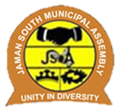Vision
To reduce rural and urban poverty and increase the standard of living of the poor through increasing access to quantitative and qualitative socio-economic infrastructure.

To reduce rural and urban poverty and increase the standard of living of the poor through increasing access to quantitative and qualitative socio-economic infrastructure.
The Jaman South Municipal Assembly exist to facilitate the improvement of quality of life of the people within the Assembly's jurisdiction through equitable provision of services for the total development of the Municipality, within the context of good governance.
Jaman South Municipal Assembly, located in the Bono Region of Ghana, is a vibrant local government body committed to fostering sustainable development, improving infrastructure, and enhancing the quality of life for its citizens. Established to promote participatory governance, the Assembly focuses on:
Our dedicated team works collaboratively to ensure transparent, accountable, and inclusive governance that aligns with national development goals.
Jaman South District Assembly was established by LI 1376 of 1988 and modfied to Jaman South District Assembly by LI 1777 of 2004 following the division of the original Assembly. With Drobo as its capital was elevated to a status of Municipality in early 2018. The capital Drobo is approximately 512 kilometers from the national capital Accra.
The Municipality is between latitudes 7o 27'N and 75 27'N (approximately) and longitudes 2o 32'N and 2o 66'West. It shares borders with Jaman North District in the North-East, Berekum Municipality in the South-East, Dormaa District in the South and La Cote D'lvoire in the West. The Municipality with its capital at Drobo has a total land area of about 552 km2 and about 130 settlements most of which are rural. The vast and arable land could give rise to agricultural activities and thereby promoting the local economic development. Relatively the location of the Municipality gives it the opportunity of developing its micro-economy base through socio-economic interations with her sister districts and La Cote D'lvoire
The relief of the Municipality is undulating and rises between 150 meters and 600 (crosscheck) meters above sea level. The land area of the district is underlain by Birimian, Buem and Dahomeyan rocks which are endowed with different types of precious minerals. The drainage pattern of the Municipality is largely dendrite and flows in a north-east and southern directions, with a few of them including Atuna, Fetenta and Ntabene tracing their sources from the southern Berekum and Dormaa Municipalities. The various water bodies could enchance fresh water fish farming while the water if carefully managed could also enhance the development of mechanized (irrigation) agriculture.
The district's climate is characterized by its location within the wet semi-equatorial region, with annual rainfall ranging between 1,200mm and 1,780mm. This region experiences two distinct rainy seasons: a major season from April to June and a minor season from September to October. The average temperature is around 25 degrees Celsius, with relative humidity levels between 70% and 80% during the rainy season.
It's worth noting that nearby regions experience varying climate conditions. For instance, the south-western equatorial climate zone receives high rainfall throughout the year, while the dry equatorial region is much drier. Temperature variations also occur, with mean monthly temperatures ranging from 27°C in August to 36°C in March.
The Jaman South Municipality in Ghana had a population of 108,388 according to the 2021 Population and Housing Census. This population is distributed with 52,567 males and 55,821 females. The municipality's annual growth rate is 1.5%.
The major crops cultivated in the District are yam, maize, cassava, rice, cocoyam and plantain. Pepper, groundnut, tomatoes and garden eggs are also produced as vegetables. Cashew, beside cocoa, is one of the fastest cash crops cultivated in the district, with many tones produced and sold in raw form annually.
The district has some sites of historic, scientific or aesthetic importance which can be exploited for recreational purposes. These include:- The Buodi scarp rich in gold minerals, the Crocodiles at Mpuasu, Zezera and its attractive terrain, The Underground calving industry at Abuokrom, The Rocky plain at Bodaa, The Ghana-La Cote D'lvoire boarder demarcation of Kwameseikrom, and Zezera. The strategic location of these towns can attract more tourists from both internal and international sources.